MetalMaster SJ-24D User manual

BEAD ROLLER
OPERATION MANUAL
Edition No :MBR-001
Date of Issue :05/2019
Model.
SJ-24D
Product Code S641
06/01/2020
Instructions Manual for SJ-24D (S641)
1

2
OPERATION MANUAL
NOTE:
In order to see the type and model of the machine, please see the
specication plate. Usually found on the back of the machine. See
example (Fig.1)
Fig.1
BEAD ROLLER
MACHINE
SJ-24D
MODEL NO.
SERIAL NO.
DATE OF MANF.
Note:
This manual is only for your reference. Owing to the continuous improvement of the
Metalmaster machines, changes may be made at any time without obligation or notice.
Please ensure the local voltage is the same as listed on the specication plate before
operating any electric machine.
Distributed by
www.machineryhouse.co.nz
MACHINE DETAILS
06/01/2020
Instructions Manual for SJ-24D (S641)
2

3
OPERATION MANUAL
C O N T E N T S:
1. GENERAL MACHINE INFORMATION
1.1 Specications................................................................. 4
1.2 Packing Contents.......................................................... 4
2. IMPORTANT INFORMATION
2.1 Safety Requirements.................................................... 5
2.2 Additional Safety For Bead Rolling Machine....... 7
3. INSTALLATION
3.1 Unpacking....................................................................... 8
3.2 Assembly.......................................................................... 8
3.3 Alignment........................................................................ 9
3.4 Changing Dies................................................................ 10
4. OPERATION
4.1 Getting Started.............................................................. 12
4.2 Creating Straight Beads.............................................. 12
4.3 Forming Curves............................................................. 13
5. MAINTENANCE
5.1 Adjusting The Upper Bearing Blocks..................... 13
Spare Parts................................................................................ 14
Risk Assessment Sheets....................................................... 17
06/01/2020
Instructions Manual for SJ-24D (S641)
3

4
OPERATION MANUAL
1.1 SPECIFICATIONS
Product Code S641
Model SJ-24D
Capacity
(mm/gauge)
Bead and Flange 1.2/18
Shear 1.0/20
Throat (mm) 460
Bead Mandrels Sizes (mm//in) 6.35//1/4,9//3/8,12.7//1/2
Flange Mandrels Sizes (mm//in) 1.6//1/16,3//1/8,6.35//1/4
Shearing Mandrel Quantity 1 Set
(A) Bead Roller Frame
(B) Crank Handle (Maybe mounted on the machine)
(C) Roller Tensioning Lever
(D) 6 Sets of rolls (Ø22mm Bore)
1/4“- (6.35mm), 3/8” (9mm), 1/2”(12.7) Single bead rolls
1/16” (1.6mm), 1/8” (3mm), 1/4” (6.35mm) Stepped rolls
(E) One set Cutting Dies (Maybe mounted on the machine)
(F) Stand (Not displayed)
1.2 PACKING CONTENTS
D
A
B
C
E
06/01/2020
Instructions Manual for SJ-24D (S641)
4

5
OPERATION MANUAL
2.1 SAFETY REQUIREMENTS
DO NOT use this machine unless you have read this manual or have been instructed in the use
of this machine in its safe use and operation
Safety glasses must be worn at
all times in work areas. Earmus
should be worn if the work area is
noisy.
Sturdy footwear must be worn
at all times in work areas.
Gloves should NOT be worn when
using this machine
Long and loose hair must be
contained with a net or under a
hat
This manual provides safety instructions on the proper setup, operation, maintenance, and
service of this machine. Save this manual, refer to it often, and use it to instruct other operators.
Failure to read, understand and follow the instructions in this manual may result in re or
serious personal injury—including amputation, electrocution, or death.
The owner of this machine is solely responsible for its safe use. This responsibility includes, but
is not limited to proper installation in a safe environment, personnel training and authorization
to use, proper inspection and maintenance, manual availability and comprehension, of the
application of the safety devices, integrity, and the use of personal protective equipment.
The manufacturer will not be held liable for injury or property damage from negligence,
improper training, machine modications or misuse.
WARNING
DISCONNECT POWER FIRST. If using power,
always disconnect the machine from power sup-
ply before making adjustments, or servicing the
machine. This prevents any risk of injury from
unintended startup or contact with live
electrical equipment
OWNER’S MANUAL. Read and understand this
owner’s manual before using the machine.
TRAINED OPERATORS ONLY. Operators that
have not been trained have a higher risk of
being seriously injured. Only allow trained or
supervised people to use this machine. When
the machine is not being used, disconnect the
power, to the machine to prevent unautho-
rized use—especially around children. Make
the workshop safe.
06/01/2020
Instructions Manual for SJ-24D (S641)
5

6
OPERATION MANUAL
WEARING PROPER APPAREL Do not wear
clothing, apparel or jewelry that can become
entangled in moving parts. Always tie back
or cover long hair. Wear non-slip footwear to
avoid accidental slips, which could cause loss of
operating control.
HEARING PROTECTION. Always wear hearing
protection when operating or observing loud
machinery. Extended exposure to this noise
without hearing protection can cause perma-
nent hearing loss.
REMOVE ADJUSTING TOOLS. Tools left on
machinery can become dangerous projectiles
upon startup. Never leave hex keys, wrenches,
or any other tools on machine. Always verify
removal before starting!
USE CORRECT TOOL FOR THE JOB. Only use
this tool for its intended purpose. Do not force
the machine or its attachments to do a job for
which they were not designed. Never make
unapproved modications. Modifying the ma-
chine or using it dierently than intended may
result in malfunction or mechanical failure that
can lead to personal injury or death!
AWKWARD POSITIONS. Keep proper footing
and balance at all times when operating ma-
chine. Do not overreach! Avoid awkward hand
positions that make operating control dicult.
This could increase the risk of accidental injury
GUARDS & COVERS. Guards and covers reduce
accidental contact with moving parts or ying
debris. Make sure they are properly installed,
undamaged, and working correctly.
FORCING MACHINERY. Do not force the ma-
chine. It will do the job safer and better at the
rate for which it was designed.
NEVER STAND ON MACHINE. Serious injury
may occur if the machine is tipped or if the
cutting tool is unintentionally contacted
STABLE MACHINE. Unexpected movement
during operation greatly increases risk of injury
or loss of control. Before starting, verify ma-
chine is stable and if using a mobile base it is
locked in position.
UNATTENDED OPERATION. To reduce the
risk of accidental injury, turn the machine OFF
and ensure all moving parts have completely
stopped before walking away. Never leave the
machine running while unattended.
MAINTAIN WITH CARE. Follow all maintenance
instructions and lubrication schedules to keep
the machine in good working condition. A
machine that is improperly maintained could
malfunction, leading to serious personal injury
or death.
CHECK DAMAGED PARTS. Regularly inspect
the machine for any condition that may af-
fect the safe operation. Immediately repair or
replace damaged or parts that are incorrectly
tted before operating.
CHILDREN & BYSTANDERS. Keep children and
bystanders at a safe distance from the work
area. Stop using machine if they become a
distraction.
2.1 SAFETY REQUIREMENTS Cont.
06/01/2020
Instructions Manual for SJ-24D (S641)
6

7
OPERATION MANUAL
DO NOT use this machine unless you have read and understand the manual and the
requirements for the safe operation of this machine.
2.2 ADDITIONAL SAFETY FOR BEAD ROLLING MACHINE
Safety glasses must be worn when
operating this equipment
Dust mask must be worn when
operating in high dust areas.
Long and loose hair must be contained
when operating this equipment.
Safety footwear must be worn when
operating this equipment
Close tting/protective clothing must
be worn when operating the machine
Hearing protection must be used when
operating in a noisy environment
PRE-OPERATIONAL SAFETY CHECKS
qLocate and ensure you are familiar with all machine operations and controls.
qEnsure all guards are tted, secure and functional. Do not operate if guards are missing or
faulty.
qWorking parts should be well lubricated and the dies are free of rust and dirt.
qCheck workspaces and walkways to ensure no slip/trip hazards are present.
qBe aware of other people in the area and ensure the area is clear before using equipment.
OPERATIONAL SAFETY CHECKS
qAdjust the chosen dies slowly and in small adjustments.
qTake care during the initial feeding of the workpiece into the dies.
qHold the workpiece suciently far back from the edge being fed into the dies, to allow for
the infeed speed of the machine.
qWind handle at a slow even rate. Be aware of rotating dies
qOnly one person should operate this machine for a safe result.
ENDING OPERATIONS AND CLEANING UP
qEnsure the machine is left in a safe condition after use.
qLeave the work area in a safe, clean and tidy state.
POTENTIAL HAZARDS AND INJURIES
qSharp edges and burrs.
qCrush and pinch points.
qHair/clothing getting caught in moving machine parts.
qOperator’s hands may be caught and drawn into the rotating dies.
DON’T
qDo not use faulty equipment. Immediately stop and repair suspect machinery.
qDo not attempt to form material beyond the capacity of the machine.
06/01/2020
Instructions Manual for SJ-24D (S641)
7

8
OPERATION MANUAL
3.1 UNPACKING
1. Place the Bead Roller on to the stand.
2. Slide the Handle (12#) onto the Driving Shaft (3#) .
3. Using a Hex Key Wrench , tighten grub screw (11#) securely . Ensure that grub screw (11#)
is positioned over the at surface on the Driving Shaft (3#) .
3.2 ASSEMBLY
This machine was carefully packaged for safe transport. When unpacking, separate all enclosed
items from packaging materials and inspect them for shipping damage. If items are damaged,
please contact your distributor.
NOTE: Save all the packaging materials until you are completely satised with the machine and
have resolved any issues with the distributor, or the shipping agent.
When unpacking, check to make sure that all parts shown on page 4 are included. If any parts
are missing or broken, please contact the your distributor.
3#
11#
12#
Fig. 3
Attaching The Roller Tension Handle
To assemble the handle to the Hafco Bead Roller
loosen the nyloc nut, (A in Fig.4) then undo and remove
the socket head set screw (B in Fig.4) so that the upper
bearing block is free to move down the shaft. Screw
the Upper Bearing Block tensioning handle into the
casting and slide the upper bearing block back so that
the end of the handle ts into the Upper Bearing Block
“T” slot. (C in Fig.4)
Screw the set screw (B in Fig.4) into the threaded hole
in the Upper Bearing Block and tighten.
While holding the socket head set screw with a hex key,
tighten the nyloc nut (A in Fig.4), then back it o half a
turn so the Upper Bearing Block can move. Fig. 4
A
B
C
06/01/2020
Instructions Manual for SJ-24D (S641)
8

9
OPERATION MANUAL
3.3 ALIGNMENT
The Bead Roller usually does not need the operator to adjust the alignment. However, poor
alignment will eect the quality of the metal forming and the ability of the machine to cut
sheet metal.
If you experience either of these problems perform the following alignment steps.
1. Set up the Bead Roller with cutting dies (10#-1, 10#-2) and cutting plate (9#) as shown in
Fig. 5.
2. Inspect the cutting plate (9#) as shown in Fig. 5. When the Bead Roller is aligned correctly,
the edges of the cutting plates should almost be touching. If they are not almost touching
then the following steps need to be taken.
3#
6# 5#
Fig. 6
3. Using the hex key wrench supplied (27#) loosen
screws (16#) that secure gear (5#) and collar (6#) to the
driving shaft (3#). (Fig. 6)
4. Slide the driving shaft (3#) until the cutting plates (9#)
are touching.
5. By hand, move collar (6#) on the driving shaft (3#) so
its edge is touching the roll block (2#) and tighten the
screws (16#)
6. Move Gear (5#) so its side is touching the Collar(6#) on
the Driving Shaft(3#) and tighten its Screws(16#). At
all times make sure that the screw is tightened on the
at on the shaft.
NOTE: If the edges are touching but the machine does
not cut the material correctly, adjust the roller tension.
See section “Adjusting The Roller Tension”(Page 11)
16#
10#-1
9#
Fig. 5
10#-2
9#
30#
13#
30#
13#
06/01/2020
Instructions Manual for SJ-24D (S641)
9

10
OPERATION MANUAL
3.4 CHANGING DIES
The Bead Roller comes with a variety of bead and ange dies, as well as the cutting dies &
plates. (assembled to the machine before shipping) Use the following instructions when you
change dies.
Removing the Cutting Dies and Plates
1. Loosen Handle(39#), See Figure 7.
2. Using a Hex Key Wrench, remove the two socket head cap screws (30#) securing the
Cutting Dies (10#-01,10#-02) to the Driving Shaft (3#) and Driven Shaft (4#). Remove the
Washers (13#).
3. Using a Hex Key Wrench(27#), loosen the Screws( 16#) that lock the Cutting Dies (10#-
01,10#-02) onto the shafts. See Figure 7.
4. Remove the Cutting Dies (10#-01,10#-02).
It may be necessary to sharpen or replace the Cutting Plates (9#) from the Dies (10#-1, 10#-2)
To Remove the Cutting Plates from the Dies
1. Using a hex key wrench, remove the eight Screws(18#) and Spring Washers(25#), securing
the Cutting Plates (9#) to the Cutting Dies(10#-01, 10#-02). See Figure 7.
3. Remove the Cutting Plates (9#).
1/4” Bead
(6.35mm)
3/8” Bead
(9mm)
1/2” Bead
(12.7mm)
1/16”Stepped
(1.6mm)
1/8” Stepped
(3mm)
1/4” Stepped
(6.35mm)
Bead and Stepped Dies
Fig. 7
4#
3#
16#
10#-01
30#
9#
18#
25# 10#-02
13#
39#
06/01/2020
Instructions Manual for SJ-24D (S641)
10

11
OPERATION MANUAL
Installing Bead and Flange Dies
1. Select the correct bead or ange dies for the job you are going to do.
2. Slide both dies onto the Driving Shaft(3#) and Driven Shaft(4#) at the same time
(see Figure 8). Ensure that the Screws(16#) are positioned over the at surface on the
Driving Shaft(3#) and Driven Shaft(4#).
3. By hand, install the two Bolts (30#) and Washers(13#).Tighten Bolts (30#) with a Hex Key
Wrench.
4. Tighten the two Screws (16#).
5. Check to ensure that the dies are aligned. If not aligned then see“Alignment” on Page 9.
Adjusting Roller Tension:
1. Adjust the Handle (39#) nger tight.
2. Using the handle, tighten 1 to 3 turns, depending on desired results.
Metalmaster advises to turn the handle slowly as you work. A variety of metals and material
gauge will produce a dierent result with the same dies and will require various degrees of
eort.
NOTE: Safety Usage
Wherever possible only one person should operate the Bead Roller. It is dangerous when more
than one person uses the machine. If one person is used to crank the handle and another is
used to guide the metal along the roller, it can be possible that lack of communication
between the two operators may cause accidents to happen. Metal forming is an art and in
some cases may require two operators. Good communication between the person cranking
and the one guiding the metal particularly on corners, is essential and all care should be taken
in these cases.
3#
39#
13#
Fig. 8
30# 16#
4#
06/01/2020
Instructions Manual for SJ-24D (S641)
11

12
OPERATION MANUAL
4. OPERATION
4.1 GETTING STARTED
• Loosen the Roller Tensioner Lever lock nut (Fig.10)
• Loosen the Roller Tensioner Lever (39#) by turning the
lever in a counter-clockwise direction. (Fig 9).
Note: The through hole in the upper frame is slotted. The
Upper Roller Shaft and Bearing Block should be free to
be raised up suciently to separate the Bead Roller Dies
enough to slide the workpiece metal between them . If
the upper Bearing Block is hard to move see “Adjusting
The Top Bearing Block” (Page. 13)
• Center the Upper Die over the previously drawn
pattern line then move the Upper Roller Shaft and
Bearing Block down in place against the metal work
piece.
• Check the alignment with the drawn line, then increase
the pressure of the Upper Roller Die by tightening the
Roller Tensioner Lever, add additional turns until the
bead is formed.
• Tighten the Roller Tensioner Lever Lock nut. (Fig. 10)
NOTE: Do Not Over tighten as this may tear the metal
workpiece, jam the Roller Dies or deform the Frame.
Fig. 11
Fig. 10
Lock nut
• Crank the handle slowly as you move the metal
making sure that the marked guideline is followed.
• Keep the marked guideline aligned with the center of
the Upper Die. When you reach the end of the guide
line, you may re-roll the bead by turning the crank in
the opposite direction.
This produces a more sharply dened bead.
• When done, loosen the Upper Roller Tensioner lock nut
and retract the Upper Shaft and Upper Die.
• Pull the workpiece panel from between the dies and
check the nished result.
4.2 CREATING STRAIGHT BEADS
NOTE: When forming beads, for greater ease in handling workpiece panels and achieving op-
timal accuracy, it is strongly advised to turn the handle slowly as you work. A variety of metals
and material gauge will produce a dierent result with the same dies and will require various
degrees of eort. Always perform a practice run with a piece of scrap material of the same type
and gauge before forming the actual workpiece.
Fig. 9
39#
06/01/2020
Instructions Manual for SJ-24D (S641)
12

13
OPERATION MANUAL
4.3 FORMING CURVES
The success to forming curves with the bead roller is
careful coordination between cranking the handle, and
moving the metal workpiece slowly through the dies,
while turning it through the curve, at the same time.
• It is critical to keep the guideline aligned with the
Upper Die as you go (Fig. 12).
• If your design forms an oval, start the bead in the
centre of a straight or in the largest radius section
• Do not attempt to start right at a corner or a joint of
two lines, as it will be extremely dicult to line up the
bead perfectly when completing the form.
• By using combinations of curves and straight lines,
there is almost no limit to the designs than can be
created with the Hafco Bead Roller.
Fig. 12
5.1 ADJUSTING THE UPPER BEARING BLOCKS
Fig. 13
Fig. 14
The accuracy and performance of the Hafco Bead Roller
is partly determined by the upper bearing blocks. They
need to move but also need to support the upper shaft
rmly. Adjustment of the Upper Bearing Blocks is critical
to producing a quality result.
To adjust the Front Bearing Block.
1. With an Hex key hold the set screw “A” in Figure 13.
2. Tighten the nyloc nut “B” in Figure 13 until the block
is tight then back the nyloc nut o half a turn or until
the block moves with the (39#) Tension Adjustment
Handle.
3. Re-test to make sure the Front Bearing Block moves
but is not loose. If still tight then back o the nyloc
nut another half turn.
To adjust the Rear Bearing Block.
1. With an Hex key hold the set screw “C” in Figure 14.
2. Tighten the nyloc nut “D” in Figure 14 until the block
is tight then back the nyloc nut o half a turn or until
the block moves with the (39#) Tension Adjustment
Handle.
3. Re-test to make sure the Rear Bearing Block moves
but is not loose. If still tight then back o the nyloc
nut another half turn.
A
B
CD
5. MAINTENANCE
06/01/2020
Instructions Manual for SJ-24D (S641)
13

14
OPERATION MANUAL
SPARE PARTS SECTION
The following section covers the spare parts diagrams and lists that were current
at the time this manual was originally printed. Due to continuous improvements
of the machine, changes may be made at any time without notication.
HOW TO ORDER SPARE PARTS
1. Have your machines model number, serial number & date of manufacture
on hand, these can be found on the specication plate mounted on the
machine
2. A scanned copy of your parts list/diagram with required spare part/s
identied
3. Go to www.machineryhouse.com.au/contactus and ll out the inquiry form
attaching a copy of scanned parts list.
06/01/2020
Instructions Manual for SJ-24D (S641)
14

15
OPERATION MANUAL
SPARE PARTS DIAGRAM
06/01/2020
Instructions Manual for SJ-24D (S641)
15

16
OPERATION MANUAL
SPARE PARTS LIST
Part No. Description Qty. Part No. Description Qty.
1
2
3
4
5
6
7
8
9
10-01
10-02
11
12
13
14
15
16
17
18
19-01
19-02
20-01
20-02
21-01
21-02
22-01
Base
Roll Block
Driving Shaft
Driven Shaft
Gear
Collar
Bolt M14x30
Washer 14mm
Cutting Plate
Long Cutting Die
Short Cutting Die
Bolt M10X20
Handle
Washer
Screw M10X20
Front Roll Block
Screw M8x10
Handle Cover
Screw M6x16
12mm Half-Round Die(Convex)
12mm Half-Round Die(Concave)
10mm Half-Round Die(Convex)
10mm Half-Round Die(Concave)
6mm Half-Round Die(Convex)
6mm Half-Round Die(Concave)
6mm Flange Die
1
3
1
1
2
2
4
4
2
1
1
1
1
2
2
1
18
1
8
1
1
1
1
1
1
1
22-02
23-01
23-02
24-01
24-02
25
26
27
28
29
30
31
32
33
34
35
36
37
38
39
40
41
42
43
44
6mm Flange Die
3mm Flange Die
3mm Flange Die
2mm Flange Die
2mm Flange Die
Spring Washer 6mm
Hex Key Wrench 4mm
Hex Key Wrench 5mm
Stand
Plate
Screw M10X20
Screw M8X20
Washer 8mm
Oil Cup
Hex Key Wrench 8mm
Washer 10mm
Gear Cover
Nut M121
Bushing 4
Adjustment Handle
Nut M142
Screw M12X110
Screw M6x10
Washer 6 mm
Hex Key Wrench 6 mm
1
1
1
1
1
8
1
1
1
4
2
8
8
4
1
2
1
1
4
1
2
1
2
2
1
`
DIE SELECTION
Note: Dies are larger than shown in this illustration
1/4” (6.35)mm Half
Round Die (21#)
3/8” (9mm) Half
Round Die (20#)
1/2” (12.7mm) Half
Round Die (19#)
1/8” (3mm) Flange
Die (23#)
1/4” (6.35mm) Flange
Die (22#)
1/16” (1.6mm) Flange
Die (24#)
06/01/2020
Instructions Manual for SJ-24D (S641)
16

General Machinery Safety Instructions
1. Read the entire Manual before starting
machinery. Machinery may cause serious injury if
not correctly used.
2. Always use correct hearing protection when
operating machinery. Machinery noise may cause
permanent hearing damage.
3. Machinery must never be used when tired, or
under the influence of drugs or alcohol. When
running machinery you must be alert at all times.
4. Wear correct Clothing. At all times remove all loose
clothing, necklaces, rings, jewelry, etc. Long hair
must be contained in a hair net. Non-slip protective
footwear must be worn.
5. Always wear correct respirators around fumes
or dust when operating machinery. Machinery
fumes & dust can cause serious respiratory illness.
Dust extractors must be used where applicable.
6. Always wear correct safety glasses. When
machining you must use the correct eye protection
to prevent injuring your eyes.
7. Keep work clean and make sure you have good
lighting. Cluttered and dark shadows may cause
accidents.
8. Personnel must be properly trained or well
supervised when operating machinery. Make
sure you have clear and safe understanding of the
machine you are operating.
9. Keep children and visitors away. Make sure
children and visitors are at a safe distance for you
work area.
10. Keep your workshop childproof. Use padlocks,
Turn off master power switches and remove start
switch keys.
11. Never leave machine unattended. Turn power off
and wait till machine has come to a complete stop
before leaving the machine unattended.
12. Make a safe working environment. Do not use
machine in a damp, wet area, or where flammable
or noxious fumes may exist.
13. Disconnect main power before service
machine. Make sure power switch is in the off
position before re-connecting.
14. Use correct amperage extension cords.
Undersized extension cords overheat and lose
power. Replace extension cords if they become
damaged.
15. Keep machine well maintained. Keep blades
sharp and clean for best and safest performance.
Follow instructions when lubricating and changing
accessories.
16. Keep machine well guarded. Make sure guards
on machine are in place and are all working
correctly.
17. Do not overreach. Keep proper footing and
balance at all times.
18. Secure workpiece. Use clamps or a vice to
hold the workpiece where practical. Keeping the
workpiece secure will free up your hand to operate
the machine and will protect hand from injury.
19. Check machine over before operating. Check
machine for damaged parts, loose bolts, Keys and
wrenches left on machine and any other conditions
that may effect the machines operation. Repair and
replace damaged parts.
20. Use recommended accessories. Refer to
instruction manual or ask correct service officer
when using accessories. The use of improper
accessories may cause the risk of injury.
21. Do not force machinery. Work at the speed and
capacity at which the machine or accessory was
designed.
22. Use correct lifting practice. Always use the
correct lifting methods when using machinery.
Incorrect lifting methods can cause serious injury.
23. Lock mobile bases. Make sure any mobile bases
are locked before using machine.
24. Allergic reactions. Certain metal shavings and
cutting fluids may cause an ellergic reaction in
people and animals, especially when cutting as the
fumes can be inhaled. Make sure you know what
type of metal and cutting fluid you will be exposed
to and how to avoid contamination.
25. Call for help. If at any time you experience
difficulties, stop the machine and call you nearest
branch service department for help.
Machinery House
requires you to read this entire Manual before using this machine.
06/01/2020
Instructions Manual for SJ-24D (S641)
17

Swage & Jenny Machine
Safety Instructions
1. Maintenance. Make sure the Swage & Jenny is
turned off and disconnect from the main power
supply and make sure all moving parts have come to
a complete stop before any inspection, adjustment
or maintenance is carried out.
2. Swage & Jenny Condition. A Swage & Jenny must
be maintained for a proper working condition. Never
operate a Swage & Jenny that has damaged or
worn parts. Scheduled routine maintenance should
performed on a scheduled basis.
3. Roll Condition. Never operate a Swage & Jenny
with a damaged or badly worn rolls. Replace if
required. Rolls should never be greased or lubricated
as rolls will slip the material and will not bend.
4. Roll Direction. Be aware of the correct rotational
axis of the motor when a qualified electrician
connects the Machine.
5. Hand Hazard. Keep hands and fingers clear from
moving parts. Serious injury can occur if hand or
finger tips get pinched by rolls and can be dragged
into machine.
6. Personal Protection. Gloves, safety glasses and
safety hat are recommended during operation.
7. Avoiding Entanglement. Swage & Jenny guards
must be used at all times. Tie up long hair and use
the correct hair nets to avoid any entanglement with
the Swage & Jenny moving parts.
8. Understand the machines controls. Make sure you
understand the use and operation of all controls.
9. Trained Operator. This machine must be operated
by authorized and trained personnel.
10. Power outage. In the event of a power failure
during use of the machine, turn off all switches
to avoid possible sudden start up once power is
restored.
11. Work area hazards. Keep the area around the
Swage & Jenny clean from oil, tools, chips. Pay
attention to other persons in the area and know
what is going on around the area to ensure
unintended accidents.
12. Guards. Do not operate Swage & Jenny without the
correct guards in place. Necessary guards protect
you from injuries by gearbox, motors and other
moving gears & parts. The only other area which
needs to be carefully monitored during use is the
rotational area of the rolls.
13. Material condition. Material must be clean of oil
and dry. Oily material can slip and will not bend.
14. Material hardness. Make sure your hardness is
the same throughout the material, we recommend
that you use certified material. Never bend hard
steel, glass or fragile material on this machine.
15. Feeding material. Making a tight bend in one pass
is not possible. So you need several passes before
you can achieve a certain radius. Tighter curves
and full radius always need more passes.
16. Stopping the Rolls. Do not stop or slow the rolls
with your hand or workpiece. Allow the Swage &
Jenny to stop on its own.
17. Emergency stop. Use the emergency stop button
in case of any emergency.
18. Hearing protection and hazards. Always wear
hearing protection as noise generated from
machine and workpiece can cause permanent
hearing loss over time.
19. Call for help. If at any time you experience
difficulties, stop the machine and call you nearest
branch service department for help.
Machinery House
requires you to read this entire Manual before using this machine.
06/01/2020
Instructions Manual for SJ-24D (S641)
18

Manager:
www.machineryhouse.com.au
www.machineryhouse.co.nz
12th March 2012
All electrical enclosures should only be opened with a tool that is not to be kept with the machine.
Wear hearing protection as required.
Machine should be installed & checked by a Licensed Electrician.
Ensure area is kept clear of material being rolled.
Revised Date:
Wear gloves to prevent cuts from material.
OTHER HAZARDS, NOISE.
Hands should be kept clear of moving parts such as rolls etc.
LOW
Risk Control Strategies
(Recommended for Purchase / Buyer / User)
Secure & support work material.
Eliminate, avoid loose clothing / Long hair etc.
Assessment
Do not adjust or clean until the machine has fully stopped.
Isolate power to machine prior to any checks or maintenance being carried out.
ENTANGLEMENT
CUTTING, STABBING,
Ensure machine is bolted down.
A
HIGH
Make sure all guards are secured shut when machine is on.
ELECTRICAL
D
MEDIUM
MEDIUM
PLANT SAFETY PROGRAM
No.
Hazard
Identification
Developed in Co-operation Between A.W.I.S.A and Australia Chamber of Manufactures
This program is based upon the Safe Work Australia, Code of Practice - Managing Risks of Plant in the Workplace ( WHSA 2011 No10 )
Safety officer:
O
Item
B
Authorised and signed by:
F
H
STRIKING
MEDIUM
Plant Safety Program to be read in conjunction with manufactures instructions
Hazard
NEW MACHINERY HAZARD IDENTIFICATION, ASSESSMENT & CONTROL
SHEARING
MEDIUM
Isolate power to machine when checks or maintenance is being carried out.
Swage & Jenny Machine
C
PUNCTURING.
LOW
CRUSHING
06/01/2020
Instructions Manual for SJ-24D (S641)
19
Table of contents
Other MetalMaster Industrial Equipment manuals

MetalMaster
MetalMaster PB-CL Series User manual
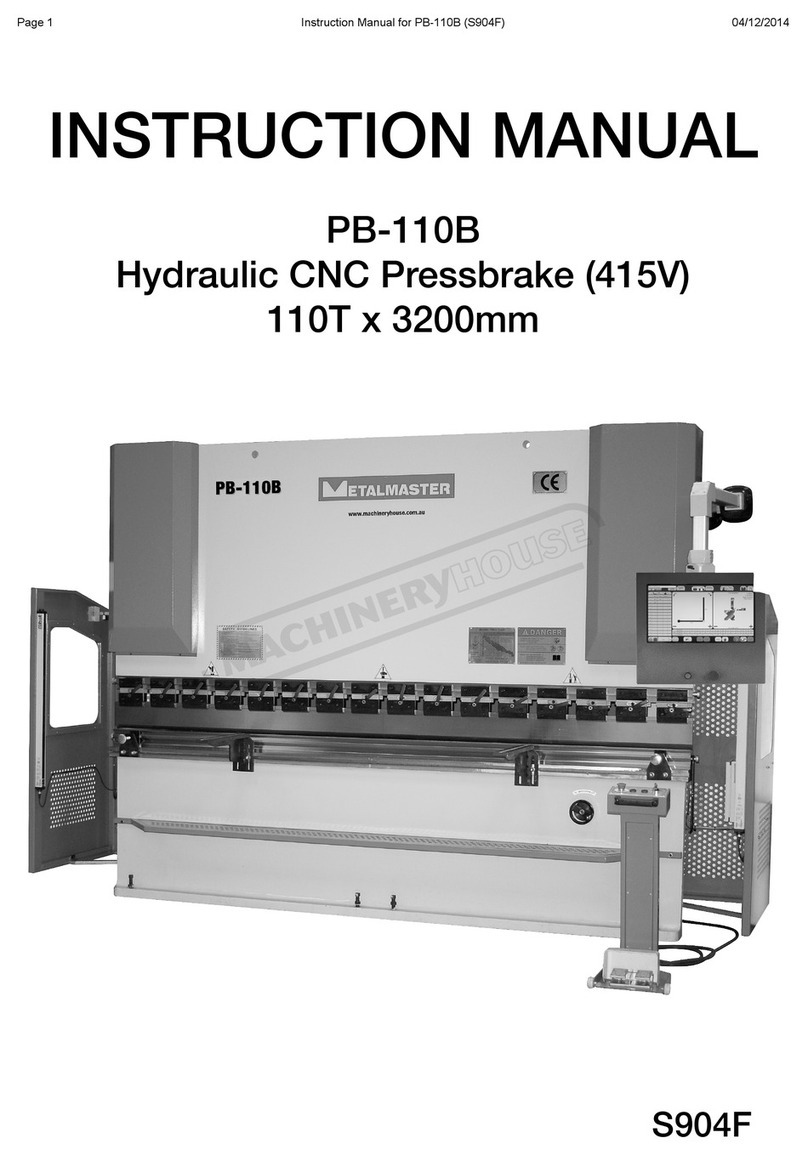
MetalMaster
MetalMaster PB-110B User manual
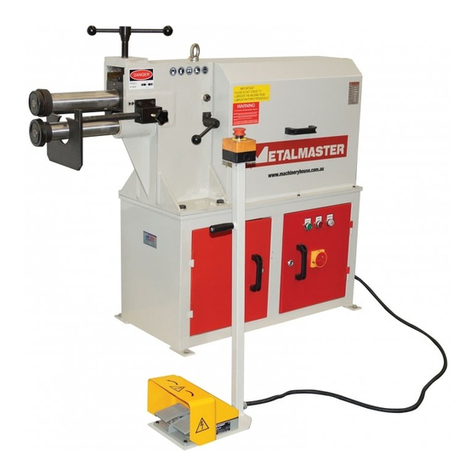
MetalMaster
MetalMaster SJM-2.5 User manual
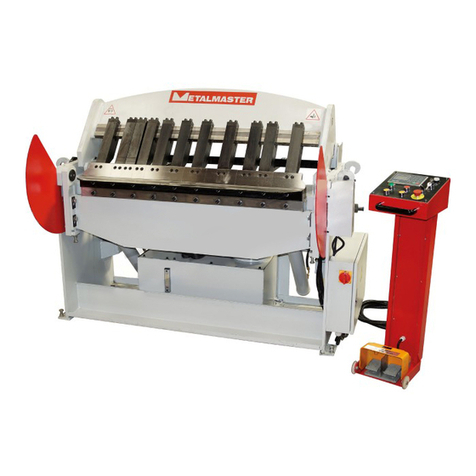
MetalMaster
MetalMaster PB-440A User manual

MetalMaster
MetalMaster SJM-1.2 User manual
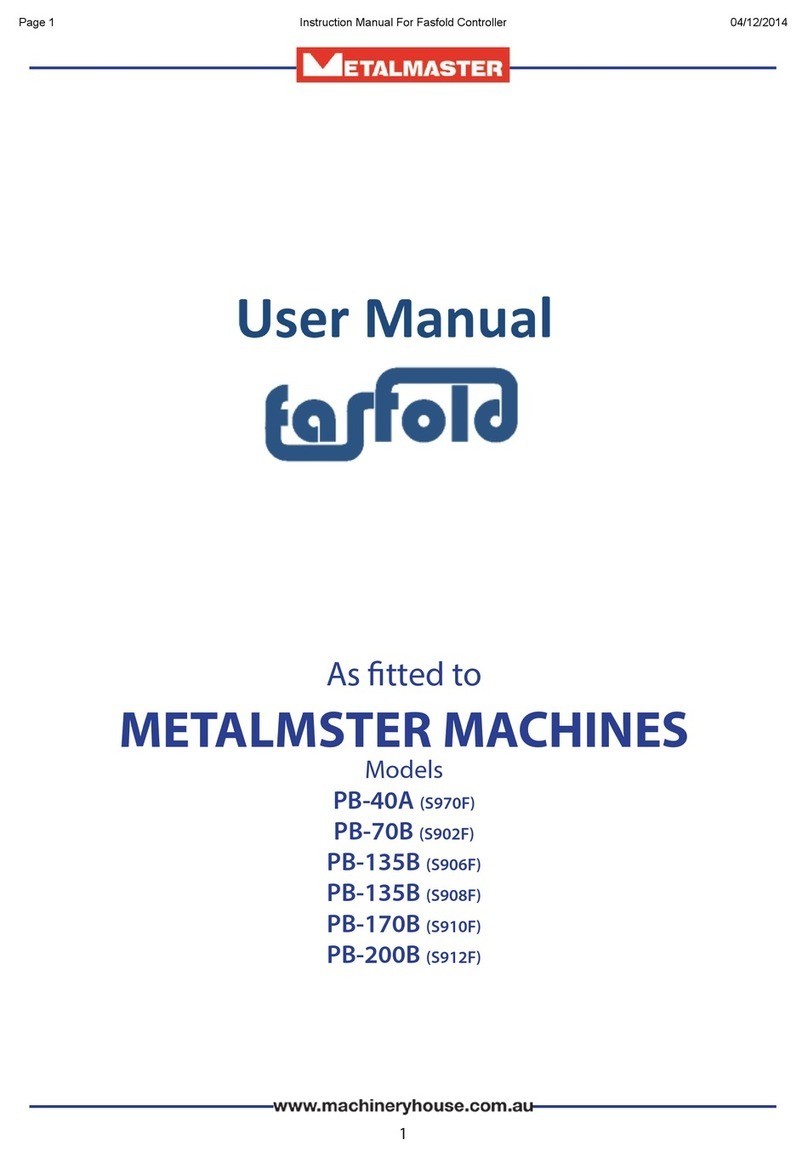
MetalMaster
MetalMaster Fasfold PB-40A User manual
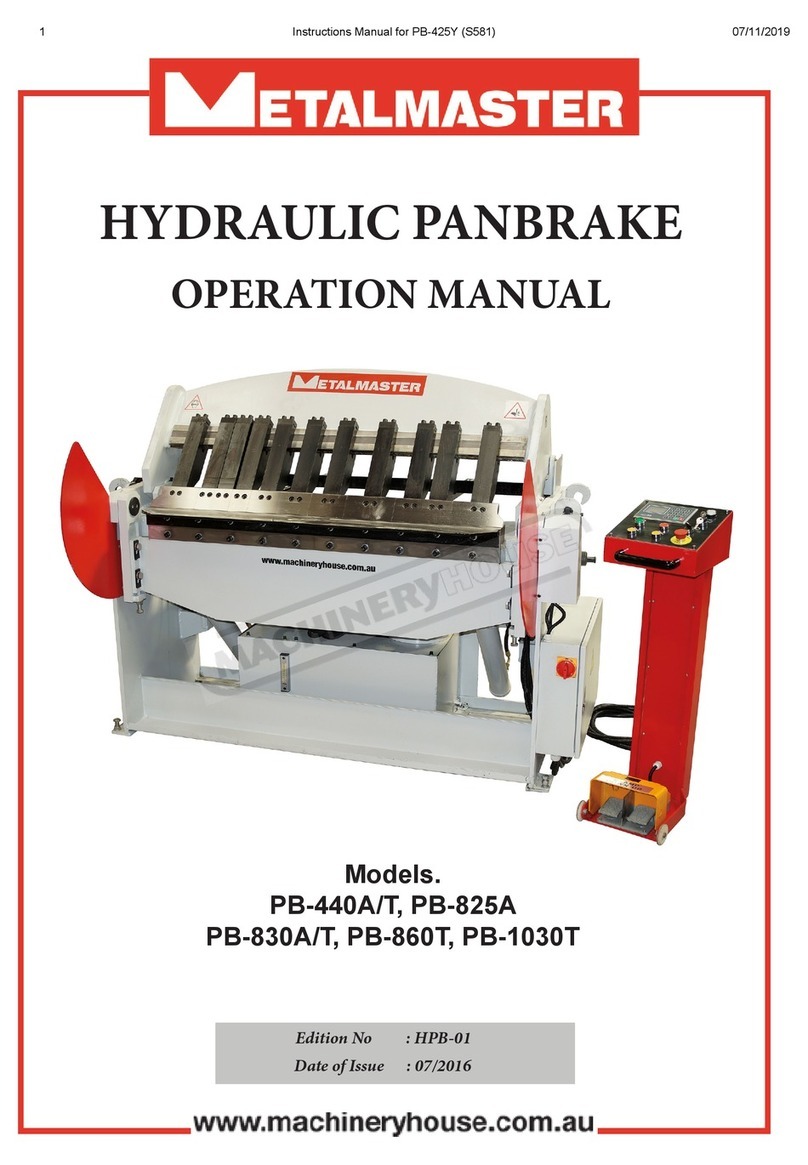
MetalMaster
MetalMaster PB-440A/T User manual
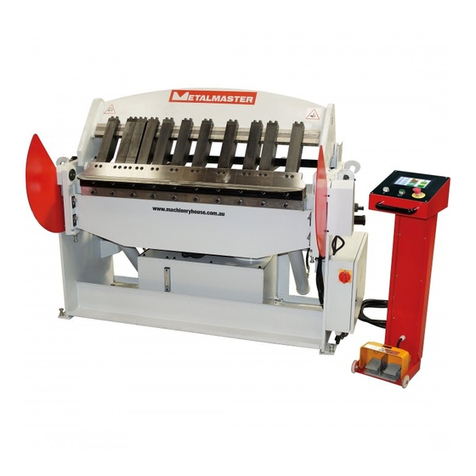
MetalMaster
MetalMaster PB-440T User manual
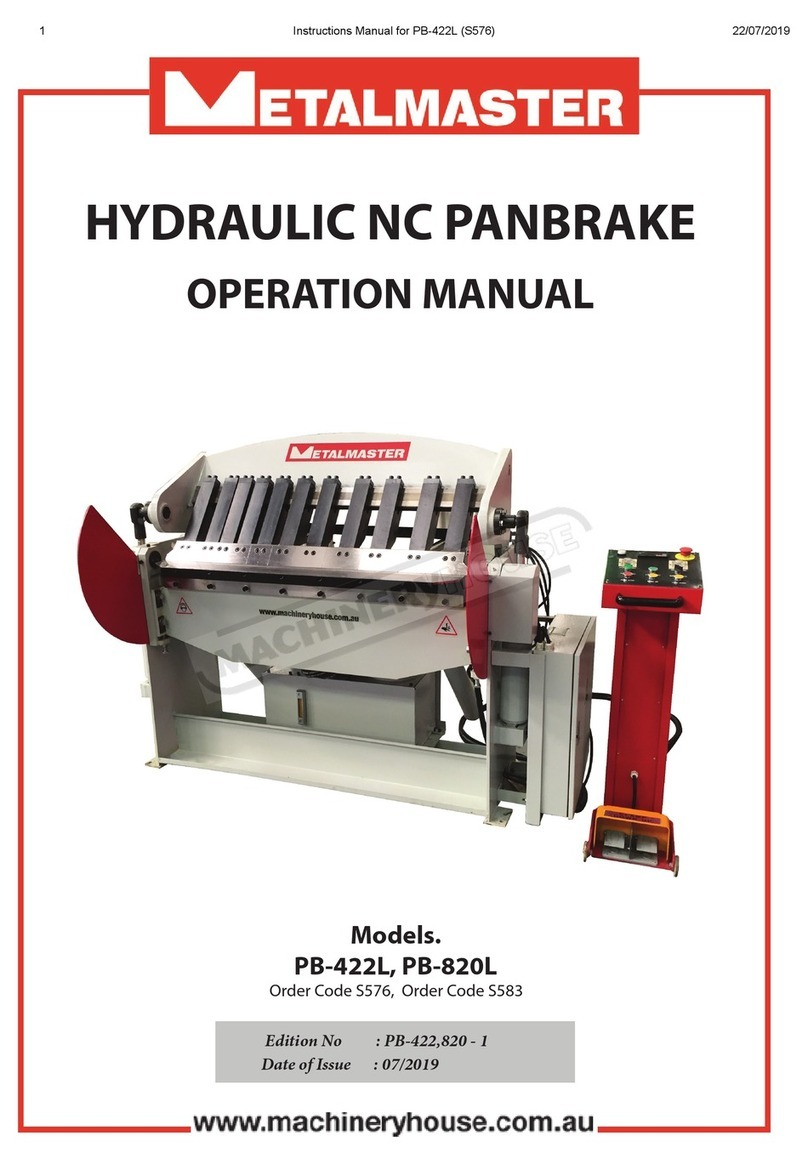
MetalMaster
MetalMaster PB-422L User manual

















